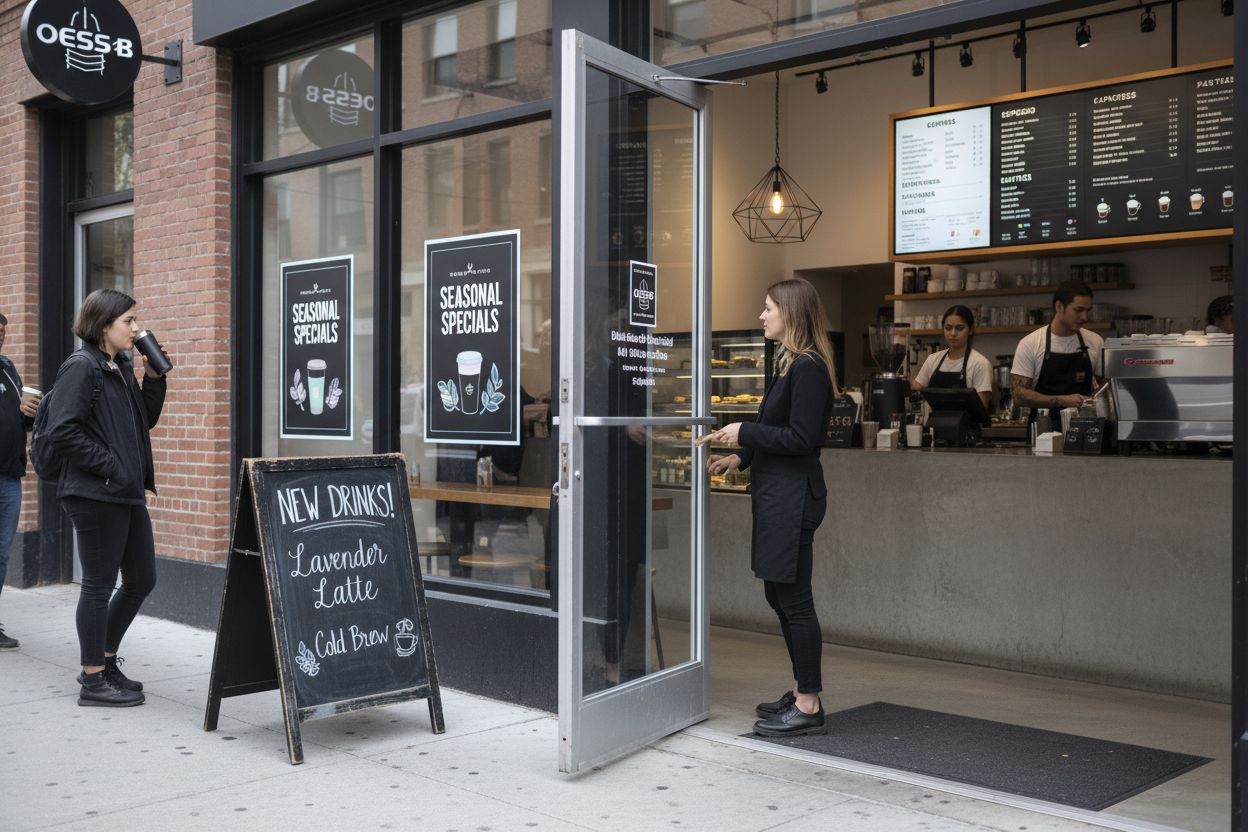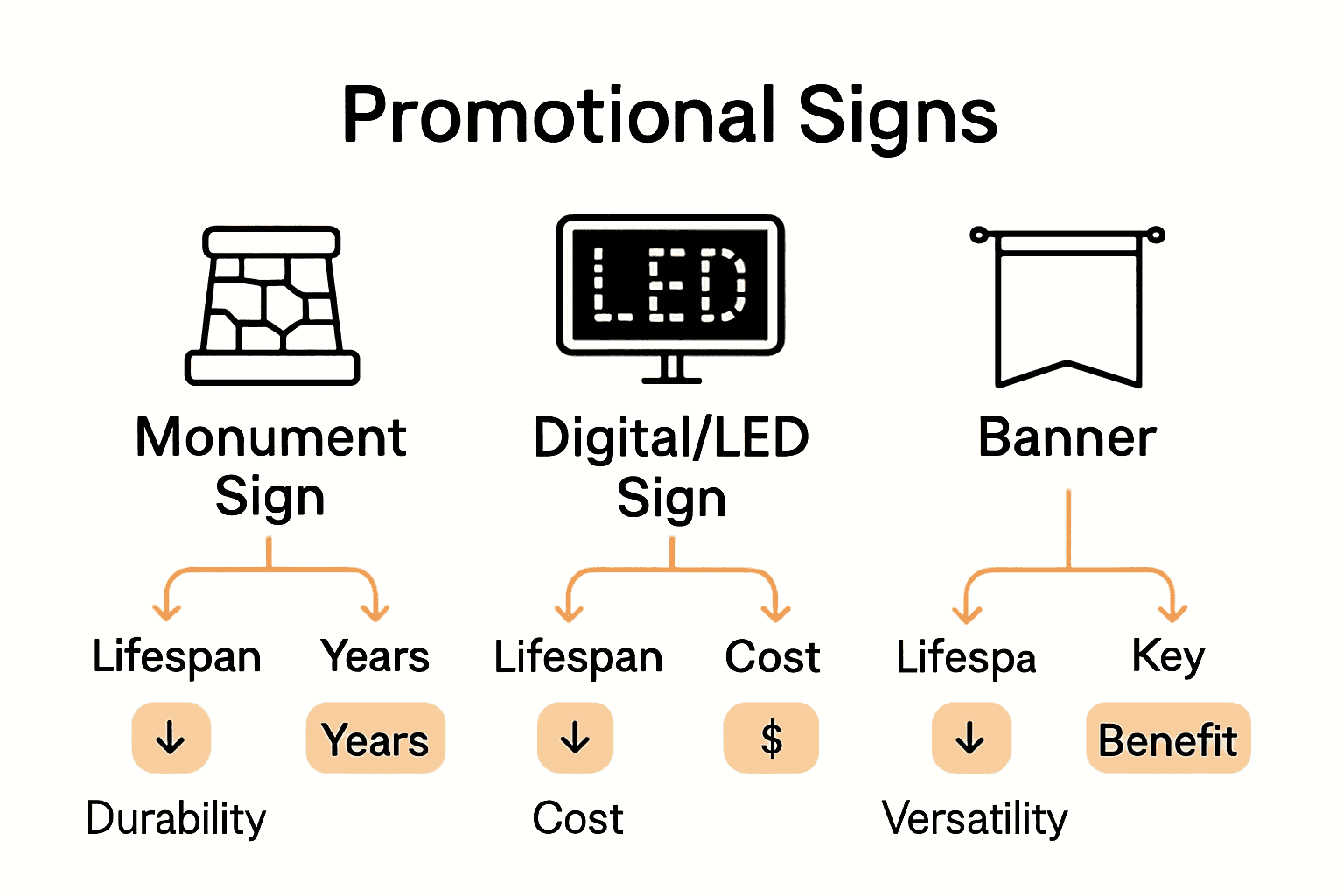{
“@type”: “Article”,
“author”: {
“url”: “https://customsignstoday.us”,
“name”: “Customsignstoday”,
“@type”: “Organization”
},
“@context”: “https://schema.org”,
“headline”: “Promotional Signs: Everything You Need to Know”,
“publisher”: {
“url”: “https://customsignstoday.us”,
“name”: “Customsignstoday”,
“@type”: “Organization”
},
“inLanguage”: “en”,
“articleBody”: “Discover what promotional signs are, explore types, design features, legal considerations, and cost factors in this comprehensive guide for businesses.”,
“description”: “Discover what promotional signs are, explore types, design features, legal considerations, and cost factors in this comprehensive guide for businesses.”,
“datePublished”: “2025-10-20T00:03:22.336Z”
}
Did you know that nearly 70 percent of consumers admit a well-designed sign can influence their buying decisions? Businesses rely on more than just word-of-mouth to stand out. The right promotional signs do more than display a message. They build brand awareness, attract curious eyes, and subtly guide customer choices. Discover how these powerful visuals become silent salespeople, making your brand unforgettable every time someone walks by.
Key Takeaways
| Point | Details |
|---|---|
| Effective Design Elements | Successful promotional signs leverage clear messaging, bold visuals, and strategic placement to capture audience attention effectively. |
| Diverse Types of Promotional Signs | Various sign types, such as monument signs and digital displays, serve specific marketing objectives and enhance brand visibility. |
| Legal Compliance | Understanding local regulations and obtaining necessary permits is crucial in avoiding legal complications with promotional signage. |
| Cost vs. Lifespan Considerations | Assessing initial costs, expected lifespans, and maintenance needs can guide effective sign selection that aligns with business goals. |
Table of Contents
- Defining Promotional Signs And Their Purpose
- Major Types Of Promotional Signs Explained
- Core Features And Effective Design Elements
- Legal And Placement Considerations In The U.S.
- Costs, Lifespan, And Choosing The Right Sign
Defining Promotional Signs and Their Purpose
Promotional signs are strategic visual communication tools designed to capture attention, communicate key messages, and drive specific business objectives. According to research from brand signage experts, these signs typically include compelling call-to-action messages like “Buy Now”, “50% Off”, or “Grab Your Deal” – purposefully crafted to influence customer behavior and prompt immediate purchasing decisions.
These visual marketing assets serve multiple critical functions beyond simple advertising. Monument signs, for instance, create a long-lasting brand presence that acts as a landmark, while window graphics transform passive spaces into active advertising platforms that invite customer engagement and reinforce brand identity. They work silently yet powerfully, communicating your brand’s personality and value proposition without saying a word.
Effective promotional signs share several key characteristics that make them powerful marketing instruments:
- Clear, concise messaging
- Strong visual design
- Strategic placement
- Compelling call-to-action
- Immediate communication of value
Whether you’re a small local business or a larger enterprise, promotional signs represent an essential communication channel that bridges the gap between your brand and potential customers. Read more about different types of promotional signage to explore how these versatile tools can elevate your marketing strategy and drive meaningful customer interactions.
Major Types of Promotional Signs Explained
Promotional signs come in diverse formats, each designed to serve specific marketing and communication objectives. According to research from sign industry experts, businesses can leverage multiple sign types to enhance their visibility and engage potential customers. Monument signs, for instance, provide a durable and permanent solution for corporate campuses and educational institutions, creating a lasting brand impression.
Large-format banners represent another powerful promotional tool. Research indicates these signs can be crafted from versatile materials like vinyl, mesh, or fabric, making them perfect for announcing sales, events, or special promotions. Complementing these are event flags – such as feather and teardrop styles – which draw attention through their distinctive scale and dynamic movement.
Here are the most common types of promotional signs:
Here’s a comparison of popular types of promotional signs and their core characteristics:
| Sign Type | Typical Location | Durability | Key Benefit |
|---|---|---|---|
| Monument Sign | Outdoor, entrances | 10-20 years | Permanent brand presence |
| Pylon Sign | Roadside, highways | 10-15 years | Maximum long-range visibility |
| Window Graphics | Windows, storefronts | 1-3 years | Transform unused space |
| Digital/LED Sign | Indoor/outdoor, freestanding | 7-12 years | Real-time message updates |
| Event Flags | Outdoor, events | 1-2 years | High motion, draws attention |
| Banners | Indoor/outdoor, temporary | 1-2 years | Low cost, easy changeover |
- Pylon Signs: Tall, pole-mounted signs offering high visibility from highways
- Blade Signs: Projecting signs ideal for pedestrian-heavy areas
- Window Graphics: Transform glass surfaces into engaging marketing platforms
- Digital/LED Signs: Dynamic displays allowing real-time message updates
- Temporary Signs: Including A-frames and portable banners for flexible marketing
Learn more about outdoor signage strategies to understand how these different sign types can be strategically deployed to maximize your business’s visual communication and brand presence.
Core Features and Effective Design Elements
Promotional sign design is a sophisticated art that combines visual communication with strategic marketing principles. Research from signage experts highlights critical design elements that transform ordinary signs into powerful marketing tools. For monument signs, this means incorporating 3D lettering for added depth, strategic landscaping integration, and intelligent lighting to ensure visibility during nighttime hours.
Visual impact plays a crucial role in capturing audience attention. According to retail signage research, effective promotional designs leverage bold, attention-grabbing visuals with specific color psychology. Urgency-inducing colors like red and orange are particularly effective, especially when strategically placed in high-traffic areas such as checkout lines or product end-caps to stimulate impulse purchases.
Key design elements for compelling promotional signs include:

- High-contrast color schemes
- Clear, readable typography
- Strategic use of white space
- Consistent brand identity
- Compelling visual hierarchy
- Adaptable design for different display contexts
Window graphics offer another nuanced design opportunity, balancing transparency with brand messaging. Successful designs integrate high-quality imagery, maintain visual clarity, and incorporate seasonal updates to keep marketing materials fresh and engaging. Learn more about effective signage design strategies to elevate your visual communication approach and create signs that truly resonate with your target audience.
Legal and Placement Considerations in the U.S.
Navigating the legal landscape of promotional signage requires careful attention to federal, state, and local regulations that govern sign placement and design. The Highway Beautification Act of 1965 establishes critical guidelines for outdoor advertising, particularly for signs near interstate and primary highways. This landmark legislation restricts sign size, spacing, lighting, and placement within 660-1000 feet of these roadways, with potential highway funding implications for non-compliant states.
Beyond highway regulations, local municipalities often have their own complex sign ordinances that businesses must carefully navigate. A landmark U.S. Supreme Court decision in City of Ladue v. Gilleo (1994) highlighted the delicate balance between municipal aesthetic regulations and constitutional free speech rights. This ruling emphasized that sign restrictions must be carefully crafted to avoid unnecessarily limiting commercial and personal expression.
Key legal considerations for promotional signs include:
- Compliance with local zoning regulations
- Adherence to size and height restrictions
- Obtaining necessary permits
- Respecting property boundaries
- Understanding commercial versus residential sign rules
- Ensuring visibility does not create safety hazards
Explore comprehensive outdoor signage guidelines to ensure your promotional signs not only capture attention but also fully comply with the intricate legal requirements across different jurisdictions. Proactive research and consultation with local authorities can help prevent potential legal complications and expensive sign removals.
Costs, Lifespan, and Choosing the Right Sign
Sign selection involves carefully balancing budget, durability, and marketing objectives. Research from sign industry experts reveals significant variations in sign lifespans across different types. Monument signs, for instance, offer remarkable longevity, lasting 10-20 years, while pylon signs typically maintain their effectiveness for 10-15 years, providing substantial long-term value for businesses seeking stable, enduring marketing solutions.
Temporary signage presents an alternative strategy for businesses seeking flexibility and cost-effectiveness. Retail signage research highlights that banners and floor graphics are particularly attractive for short-term promotions, offering easy mobility and quick updates at a lower investment point. Digital and LED signs represent another strategic option, with an average lifespan of 7-12 years when properly maintained, making them an increasingly popular choice for dynamic, adaptable marketing communications.
Consider these critical factors when choosing promotional signs:

- Initial investment costs
- Expected lifespan
- Maintenance requirements
- Visibility and placement potential
- Brand alignment
- Material durability
- Frequency of message updates
Explore custom sign design strategies to understand how to maximize your signage investment and select the most appropriate solution for your specific business needs and marketing goals.
Ready to Transform Your Marketing With Powerful Promotional Signs?
Selecting the right promotional signage can feel overwhelming when you need to balance durability, messaging, and local compliance. If you are struggling to find a sign solution that stands out, follows regulations, and matches your brand identity, you are not alone. Many business owners want signs that deliver immediate impact, drive customer action, and remain cost-effective over time.

Discover how our custom sign solutions at Custom Signs Today tackle these challenges head-on. We deliver high-quality banners, window graphics, monument signs, and more. Each sign is tailored specifically for your goals so your message never gets lost. Whether you are announcing a sale, promoting a grand opening, or building long-term brand awareness, our experts guide you from design to installation. Ready to see what is possible? Visit our website or browse all options in our category page and request your free quote today. Make your next promotional campaign unforgettable—start now and stand out where it matters most.
Frequently Asked Questions
What are promotional signs used for?
Promotional signs are used to capture attention, communicate messages, and drive business objectives through visual marketing. They include calls-to-action like ‘Buy Now’ or ‘50% Off’ and help influence customer behavior and purchasing decisions.
What are the different types of promotional signs?
Common types of promotional signs include monument signs, pylon signs, window graphics, digital/LED signs, event flags, and banners. Each type serves unique marketing purposes, from providing a lasting brand presence to offering dynamic messaging updates.
How can I design an effective promotional sign?
To design an effective promotional sign, focus on high-contrast color schemes, clear typography, strategic white space usage, consistent brand identity, and a compelling visual hierarchy. Incorporating attention-grabbing visuals and urgent colors can also enhance effectiveness.
What legal considerations should I be aware of when using promotional signs?
Legal considerations include compliance with local zoning regulations, size and height restrictions, obtaining necessary permits, and ensuring visibility does not create safety hazards. It’s important to research municipal ordinances to avoid legal complications.
Recommended
- Understanding Types of Promotional Signage for Businesses –
- Blog –
- Blog –
- Guide to Outdoor Event Signage: Create Effective Signs –
- Understanding Digital Signage for Offices: Key Insights – Projector Display
- 7 отлични рекламни материали за строителни компании – Revva – Ино

